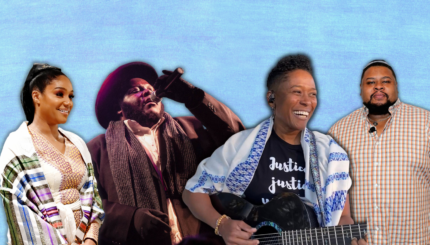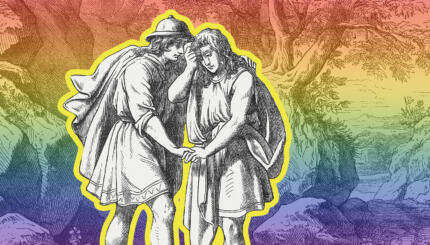The second half of the 20th century saw more change in social mores and roles than the world had seen in centuries. Together with the unprecedented affluence of post-war America and the choices and opportunities that came with it, few established institutions and social systems emerged from the period unchanged. The rabbinate is no exception. No Jewish denomination Judaism has seen the rabbinate emerge totally unscathed from the social transformations of late 20th-century America.
Women Rabbis
Though the question of women in the rabbinate was formally raised in the Reform movement as early as 1922, it wasn’t until the 1960s and 1970s, as feminism spread and growing numbers of women sought education and careers outside of the home, that the idea took flight.
When the Reconstructionist Rabbinical College opened in 1968, it became the first seminary to admit women. In 1972, however, the Reform movement became the first to actually ordain a woman, Sally Preisand. Sandy Eisenberg Sasso was ordained as the first female Reconstructionist rabbi two years later. In the Conservative movement, where allegiance to traditional notions of halakhah (Jewish law) remained stronger, the issue proved more contentious. In the late 1970s the Jewish Theological Seminary discussed, studied, and ultimately decided to postpone a decision on women rabbis.
In 1983, the question was raised again, and this time Conservative leaders voted in favor of ordaining women. The decision proved so controversial that some rabbis left the movement and founded an alternative seminary and communal organization, the Union for Traditional Judaism. Nevertheless, 18 women entered JTS in 1984, and in 1985, Amy Eilberg became the first woman to be ordained as a Conservative rabbi.

Help us keep Jewish knowledge accessible to millions of people around the world.
Your donation to My Jewish Learning fuels endless journeys of Jewish discovery. With your help, My Jewish Learning can continue to provide nonstop opportunities for learning, connection and growth.
The Orthodox movement remains the only major denomination with a male-only rabbinate. The question of Orthodox women in the rabbinate, however, is not entirely moot. With Orthodox girls in many communities receiving a Judaic education on par with their male counterparts, and Orthodox women pursuing advanced degrees and careers in everything from medicine to academia, some Orthodox rabbis and leaders have called for women to be ordained as rabbis as well, including the Los Angeles-based rabbi Yosef Kanefsky and the well-known Orthodox feminist author Blu Greenberg.
One woman, Mimi Feigelson, was ordained by a panel of three Orthodox rabbis following the death of the teacher with whom she’d studied for the rabbinate, Rabbi Shlomo Carlebach. At least one other woman, Haviva Ner-David, was ordained privately by the rabbi with whom she trained and studied, and other women are pursuing this route.
In the meantime, women in some Orthodox communities are finding ways to achieve new levels of communal and ritual leadership without the title of rabbi. They may run prayer groups, serve as official capacities in roles called “resident scholar” or “madrikha ruhanit (spiritual leader)” in synagogues, and work as advisors on and even deciders of Jewish law, especially as it pertains to questions of family purity.
As the debate continues in the Orthodox world, women’s presence in non-Orthodox seminaries has quickly grown. Only eight years after Eilberg became the first female Conservative rabbi, women comprised more than half of the Jewish Theological Seminary’s 1993 graduating class of rabbis, though those numbers did not hold up in the same way in subsequent years. In the Reform movement, women became a majority of rabbinical students around 2000, and the percentage has continued to grow–to more than two-thirds of the 2007 graduating class.
As more women become ordained, the influence of women in the rabbinate is only beginning to show. Women have now held key leadership posts in both the Conservative and Reform movements. And while there have been complaints that few women have become senior rabbis at large synagogues, it’s hard to imagine that fact remaining true for long, as women rabbis grow more accepted, more experienced, and more numerous.
Gay Rabbis
Just as women’s ordination followed on the heels of the widespread growth of feminism, the debate over ordaining gay and lesbian rabbis followed the trajectory of the gay rights movement itself. As gay, lesbian, and transgender people gained more recognition, rights, and prominence in American society, the various non-Orthodox denominations began re-examining the exclusion of homosexuals from the rabbinate and began revising their policies accordingly.
Raised at first tentatively in the 1970s, the issue gained steam in the 1980s and 1990s, and continued to be controversial into the early years of the 21st century. As with the ordination of women, the Reconstructionist movement was the first to change its policy, deciding in 1984 to admit gay and lesbians to the rabbinate. The Reform movement followed in 1990.
In the Conservative movement, the issue proved at least as (and possibly more) controversial as ordaining women rabbis. After years of rancorous debate, the denomination’s Committee on Jewish Law and Standards in late 2006 passed three different measures, one allowing gay rabbis and the other two forbidding it.
The split decisions essentially left it up to individual seminaries and synagogues to decide whether to accept gay rabbis. All eyes shifted to the Jewish Theological Seminary, the largest and most influential Conservative seminary, where the debate had raged for years. The school announced in March 2007 that it would begin accepting gay and lesbian students to its rabbinical and cantorial programs.
It’s difficult to know how many gay and lesbian students are at these seminaries–or how many have studied and been ordained at them in the past while remaining quiet about their sexual orientation. In the Orthodox movement, there are few voices advocating the acceptance of gays and lesbians into communal life, let alone the rabbinate. But, as with the question of women, it’s not an entirely verboten conversation in some parts of the Orthodox world.
At least one Orthodox rabbi, Steven Greenberg–ordained by the flagship modern Orthodox seminary, Yeshiva University–came out as gay and has been increasingly public about his own struggle with his sexuality, his coming to accept who he is, and his efforts to have gay people accepted in the Orthodox world. Greenberg authored the book Wrestling With God & Men: Homosexuality in the Jewish Tradition, and appeared prominently in a film about Orthodox gays and lesbians, Trembling Before G-d.
Second-Career Rabbis
Another new trend that has impacted the demographics of today’s rabbinical seminaries is the proliferation of second-career rabbis–men and women who have decided to pursue rabbinic ordination after years of working in entirely different professions, including law, engineering, and journalism. They have decided to switch professions and become rabbis for any number of reasons: pursuing the idealistic career they always wanted to, feeling that they’ve made enough money and can make the financial sacrifice required to pursue ordination, or deciding that their previous career decision was unfulfilling.
The number of these so-called second-career rabbinical students changes year to year, but by all accounts, it has grown dramatically in the recent past. At the Reform HUC, for instance, second-career rabbinical students account for about 15 percent of rabbinical students. Second-career rabbis are bringing new perspectives to the rabbinate because of their previous professional experiences and the fact that they are older than the average rabbinical student or new rabbi.
New Seminaries
It’s not just the pool of eligible rabbinical students and rabbis that has expanded. The options for rabbinical education have also broadened from the days when would be-rabbis essentially had one option per denomination: Hebrew Union College–Jewish Institute of Religion (HUC-JIR), both in New York and Cincinnati, for Reform; Jewish Theological Seminary (JTS) for Conservative; Yeshiva University (YU) for Modern Orthodox; and Reconstructionist Rabbinical College (RRC) for members of that denomination. (There were always numerous options for haredi, or ultra-Orthodox Jews.)
The University of Judaism (now called American Jewish University) in Los Angeles, a Conservative institution that had started as a preparatory program for students hoping to attend JTS, began its own ordination program in 1996. A new modern Orthodox seminary was founded in New York in 1999, Yeshivat Chovevei Torah, which is in some ways more liberal than Yeshiva University. And more recently, a Reform rabbinic preparatory program at the Hebrew Union College-Jewish Institute of Religion in L.A. in 2002 also began ordaining rabbis.
At the same time, options outside of the “Big Four” denominations have cropped up: the Academy for the Jewish Religion, a transdenominational seminary in New York; the aforementioned Union for Traditional Judaism in New Jersey; the Jewish Renewal movement’s ALEPH Rabbinical Program in Philadelphia; and the trans-denominational Hebrew College Rabbinical School in Boston. The Shalom Hartman Institute in Jerusalem, a trans-denominational research and educational institution founded by the Orthodox Rabbi David Hartman, also recently announced it would start a program to ordain students, male and female, as “rabbi-educators”–as opposed to pulpit rabbis–in any denomination they wish, including Orthodoxy.
There is no single reason why these new options have come into being when they have. In a pragmatic sense, they offer geographical diversity. But many also appeal to students who might not fit neatly into denominational categories. They symbolize–and are a product of–the weakening of the denominational bodies; Jews today define themselves less and less by their denomination, and tend to be more fluid in drifting between them.
New schools, new faces, new types of people. The rabbinate will never be the same–and hundreds of rabbis, and thousands of their congregants and students, are thankful for that.


